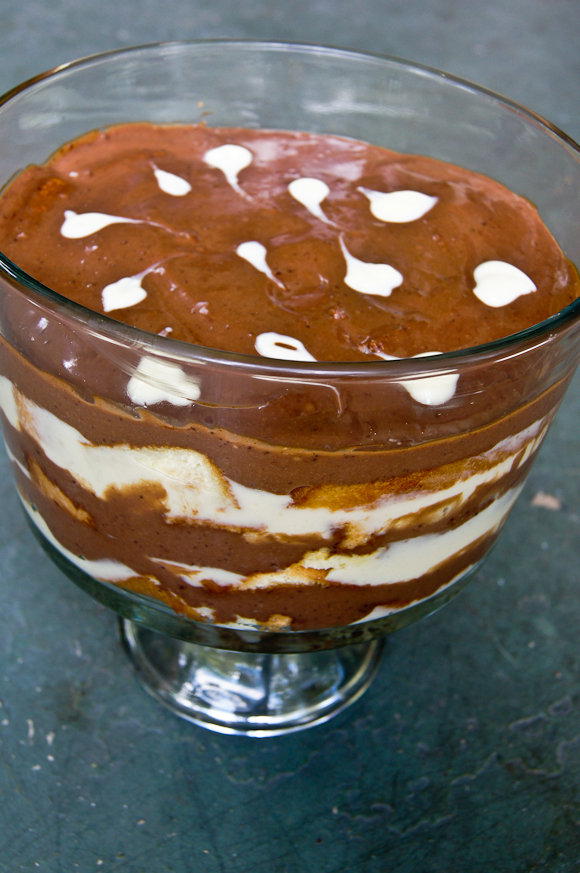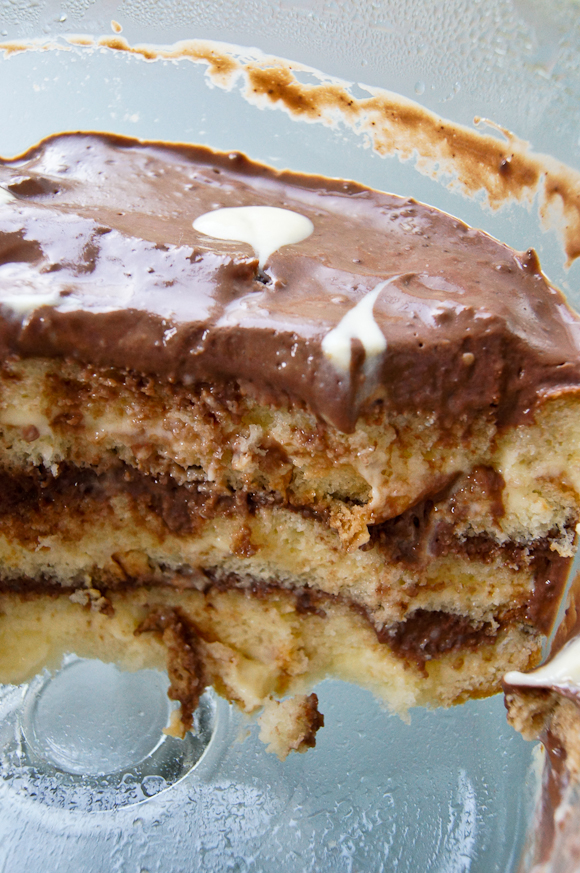Zuppa Inglese

This past Monday was Tom’s birthday. And a couple of weeks ago as we were sitting planning “Tomfest” (as he likes to call it) I asked the question that I was dreading: “So, what do you want me to bake for your birthday?”
Notice that I did not say, “What type of CAKE you want for your birthday?”
See the cake crazy person in the relationship is me – Tom is all about pies and cooked fruit desserts.
I was hoping that he did not… Because ever since I made that thing, he has been sending hints left and right for a do over.
I have been busy ignoring him.
So holding my breath and crossing my fingers, I gave him the puppy eyes and hoped for the best.
“Make me your favorite”
I did a double take… “WHATTT????”
I wanted to make sure and double-checked that I heard him right. “You want me to make you the Zuppa Inglese?”
To which he responded with a simple “yep”.
Guys, I danced the happy dance for days!
Above all other desserts that I have learned to make from my nonna, this one is the one that has the most sentimental value.
She used to make it for my Dad, who loves it, and I guess I was born with that same gene, because it was the dessert that I would request the most during my childhood. My grandmother would always make it if she knew I was arriving for a visit. As soon as I would put my suitcase down I would make a bee-line run to her kitchen, where I would open the refrigerator and sure enough, I would find it, sitting there in its colorful trifle bowl ready to be eaten – most of the time there was no need to use a plate, I would take a spoon and just eat it right out of the bowl.
The word “Zuppa” in Italian cuisine refers to both sweet and savory dishes. It comes from the verb “inzuppare” which means, “to dunk”. It is called a Zuppa because the sponge cake or Lady fingers are dipped in liqueur.
To make Zuppa Inglese, pan di spagna (sponge cake) or soft biscuits known as savoiardi (ladyfingers) are dipped in Alchermes, a bright red, extremely aromatic Italian herb liqueur and alternated with layers of crema pasticciera (pastry cream) which is a thick homemade egg custard cooked with a large piece of lemon zest (removed afterwards). Often there is also a layer of crema alla cioccolata (chocolate cream) made by dissolving dark chocolate in a plain crema pasticciera.
Before I give you the recipe I would like to point out a couple of tips:
While some recipes make it with the ladyfingers – my grandmother told me to always make it with the sponge cake, it just comes out better. I have to agree, since I have done it both ways, and the one with the sponge cake is by far the best version.
This is not a complicated dessert to make, but make it the night before you serve it. It needs those 24 hours to sit and let those flavors develop and the sponge cake soak up all that syrup goodness.
You can use the original Alchermes liqueur, but my grandmother used to make it with rum instead, and I actually prefer that essence instead of the red spirit. Plus, the Alchermes is sometimes a bit difficult to find.

ZUPPA INGLESE
for the sponge cake
- 6 eggs (at room temperature) separated
- 1 cup sugar
- 2 teaspoons of almond extract (or vanilla)
- pinch of salt
- ½ teaspoon cream of tartar (optional)
- 1 cup flour - sifted
Preheat oven to 350°F. Lightly grease and flour an 8 or 9 inch cake pan. Line bottom with parchment paper.
In a large bowl beat egg yolks to break them up, add ¾ cup sugar and continue to beat until mixture falls from beaters in a ribbon and leaves a slowly dissolving trail on the surface (Ribbon stage). Beat in almond extract.
In a separate large bowl, beat egg whites until just foamy; add salt and cream of tartar at this point as well if using. Beat whites to soft peaks, add remaining ¼ cup sugar and beat until stiff, glossy peaks form.
Fold flour into yolk mixture in three stages. Then fold in one third of whites to lighten. Very gently fold in remaining whites, fill prepare pan with the batter.
Bake until pale gold color, the top should spring back when pressed gently with finger, and a wooden skewer inserted in center comes out clean - Usually about 20 to 30 minutes. Cool in pan 10 minutes, then turn out onto rack and cool completely.
CREMA PASTICCIERA (PASTRY CREAM)
- 8 egg yolks
- 750 grams (3 cups) sugar
- 75 grams (1/2 cup) flour
- 1 lime rind
- 1 liter (4 cups) milk
- 2 teaspoons Vanilla extract
- 2- 3 ounces of dark bittersweet chocolate – (60%) chopped into small pieces
- 1 to 2 tablespoon of cocoa powder
Heat the milk with the lime rind in the saucepan over medium-high heat until it’s hot, almost but not quite at the boiling point – you will see little bubbles just beginning to form around the edge of the saucepan. Pre-heating the milk helps to cut down on the cooking time, but you don’t want the milk so hot that it will cook the eggs. Take it off the heat and put aside while you mix the yolks.
In one of the mixing bowls, whisk together the egg yolks and sugar until smooth and thick. Whisk in the flour. If it’s very thick, you can add a couple of the warm milk to loosen it up.
Slowly pour in the warm milk while whisking the egg-sugar mixture constantly. Transfer the mixture back to the saucepan and put back on the burner.
Cook the mixture over medium heat, stirring constantly with your spoon (or whisk) so the bottom doesn’t scorch. It will quickly start to thicken to the consistency of pudding. When large steamy bubbles start to pop through the liquid, the pastry cream is nearly done. (At this point, you’re cooking the flour so your cream doesn’t end up tasting chalky.)
Continue stirring for 1-2 minutes longer. Set the strainer over a clean bowl and strain the pastry cream to get out any lumps and the lime rind. Add the vanilla extract.
Separate the pastry cream in equal parts into two bowls. Cover one, you have finished the vanilla flavor.
In the other, add the chopped dark chocolate and stir to melt. At this point I like to also add some cocoa – I start with 1 tablespoon and taste my chocolate and if it needs it, add another tablespoon – I like my pastry cream to have a very strong chocolate flavor - but if you don’t, you can skip the cocoa step.
Press a piece of plastic wrap against the surface of the pastry creams and refrigerate until you’re ready to use it.
SYRUP
- 1 cup water
- ½ cup sugar
- 3 tablespoons of dark rum (optional, but highly recommended!)
In a small saucepan, mix the water and sugar over medium high heat until the sugar is fully dissolved. Take out of the heat and add the rum. Put aside to cool.

ASSEMBLY
Cut the sponge cake into strips
Using a glass dish, make a layer of the sponge cake and brush with the syrup to moisten – use more than you think you need, the sponge cake really sucks up the syrup!
Start with any flavor of the pastry cream – I always start with chocolate, don’t know why, but I guess that is how my nonna did it and I’m one to follow old traditions – and spread it evenly around covering the sponge cake.
Top with another layer of sponge cake strips, brush with the syrup and top with the vanilla cream.
Repeat making layers in this way until you have run out of ingredients or filled your bowl. End with a layer of the plain crema.
Place the bowl in the fridge and let the zuppa inglese rest for a good few hours. Some recipes call for as little as an hour and as much as a whole day. To my mind, 2-3 hours is probably the minimum to allow the flavors to blend and the crema and cake layers to adhere properly, but I highly recommend 24 hours. The dish will change in texture the longer it rests, getting softer over time. It’s a matter of taste, really, at what point it is at its best.
Now get those spoons ready and dig in, because soon it will look like this…

